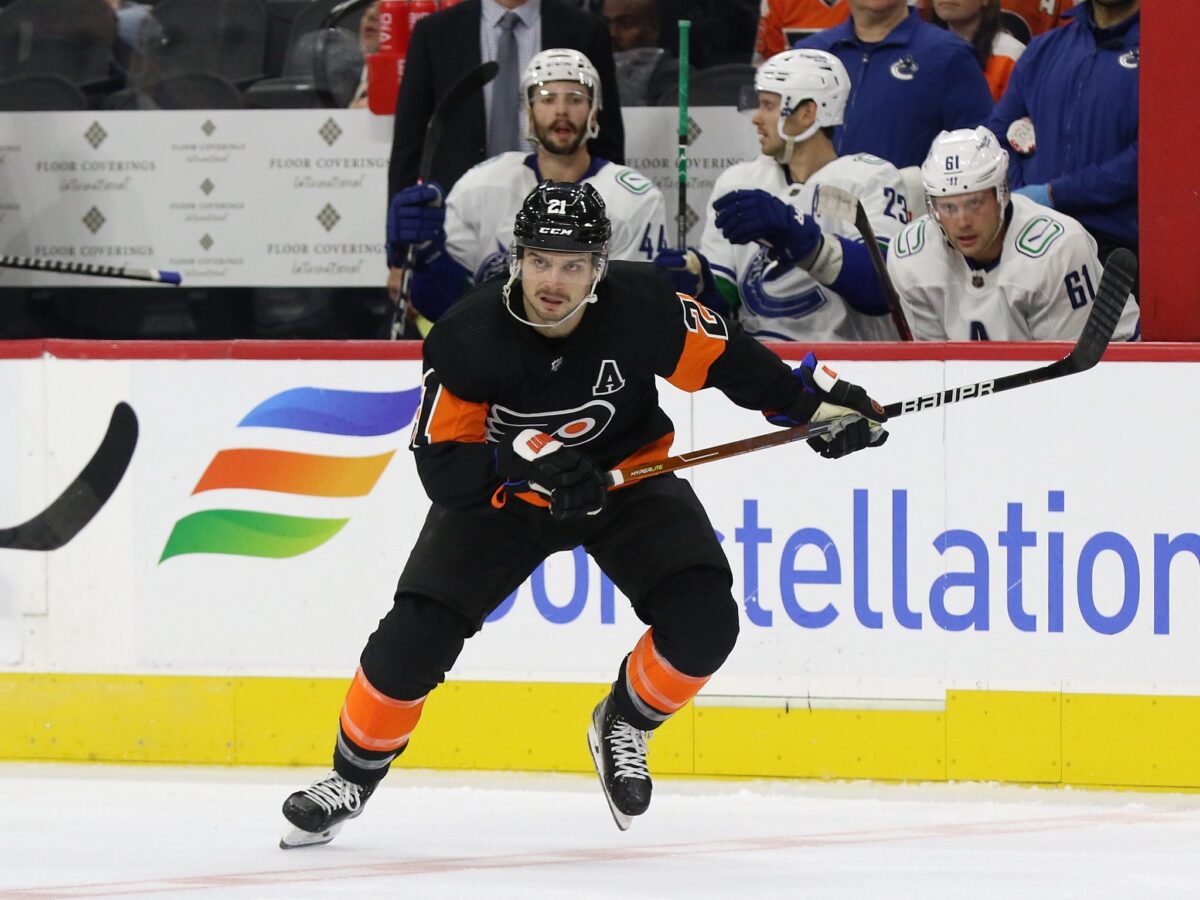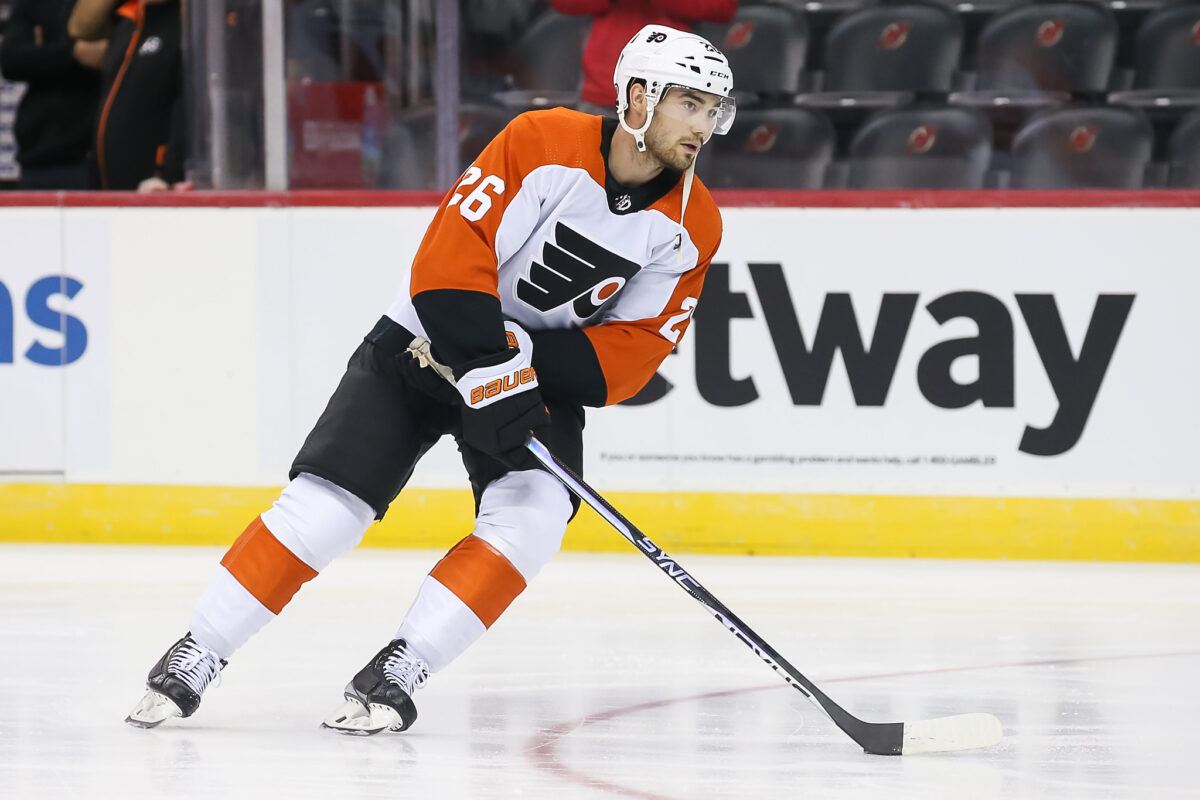Last offseason, Frank Seravalli reported that the Philadelphia Flyers turned down a 1st and 2nd round pick from the St. Louis Blues in exchange for Scott Laughton. At first, this would seem like a ridiculous decision for a team that had recently admitted to being in a rebuild to make. Laughton had just turned 29 when the trade was proposed, which would’ve given the Flyers their third pick of the 2023 NHL Draft (the Blues had picks No. 25 and 29 — it’s unclear which would’ve been dealt). He’d topped 40 points once in his career and has never reached 20 goals in a season.
Why did the Flyers hold off? Well, that one 40-point season in Laughton’s career did come in 2022-23. Laughton was one of the top forwards on the Flyers’ penalty kill, one of their few bright spots last season. Even more important, though, was Laughton’s place in the dressing room. Laughton was the only player to wear an “A” during John Tortorella’s first season as the team’s head coach. Only Sean Couturier has been a member of the Flyers longer than Laughton, and he was injured for all of 2022-23.
The odds of being around when the Flyers return to excellence are low. But the Flyers felt like Laughton was too important to bridging the gap to move at the moment. And, of course, given that Laughton is signed through 2026 at a $3 million cap hit, it wasn’t an all-or-nothing situation for general manager Danny Brière.
So, how does that decision hold up now? The Flyers have been one of the NHL’s biggest surprises this season. They are eighth in the Eastern Conference by points percentage and 6-0-2 in their last eight games. The rebuild isn’t over, but few expected the Flyers to play as well as they have this season. Maybe the Flyers wouldn’t be playing quite as well without the versatility or leadership of Laughton on their roster.

But it’s not like Laughton making much of an impact, at least on the ice. After scoring a career-high 18 goals last year, Laughton has just two through 30 games this season. His underlying numbers have severely regressed as well, with Laughton grading out poorly from a play-driving standpoint. Laughton’s ice time has dropped over 2:30 per game from where it was a season ago (from ‘How Flyers’ Scott Laughton had a career year by remaining the same core player,’ The Athletic, July 20, 2023).
All of this probably hasn’t torpedoed Laughton’s trade value. He provides a lot off the ice as well — he’s still the only Flyer wearing a letter — and a bad 30-game stretch doesn’t erase years of productive play. However, it’s fair to wonder if that offer from the Blues is the best the Flyers will ever receive for Laughton. It’s something Brière and the Flyers front office will have to monitor — and not just for Laughton but for numerous Flyers players over the next few years.
To Trade Or Not to Trade (And If So, When)
This is not a conundrum unique to the Flyers. Any team in a rebuild will have unexpected players step up during their lean years. Rebuilds afford special opportunities that players otherwise would not get, with top-of-the-lineup spots often there for the taking. Veterans who had always previously played depth roles or unheralded prospects in the right place at the right time take advantage.
But that doesn’t necessarily mean the seemingly upgraded version of those players is who they truly are. One of the easiest ways to torpedo a rebuild is biting on the fool’s gold of these players. Mistaking someone taking advantage of an opportunity for a core piece and locking them into a big contract can come back to bite a team when they become displaced by the top prospects they’ve spent the rebuild accumulating and are no longer worth their increased cap hits.
If the Flyers had signed Laughton to a big contract last summer, it would’ve represented a case of this. There was an easy explanation for Laughton’s increased scoring totals a year ago. With Couturier’s injury, the Claude Giroux trade, and other developments that weakened Philadelphia’s roster, Laughton was all but gift-wrapped a top-six role. Laughton’s points per 60 only jumped by 0.17 in all situations and regressed by 0.35 at 5-on-5 from 2021-22 to 22-23.
Laughton’s points per 60 at 5-on-5 have only dropped by 0.09 from last season to this one. Combine the decreasing ice time due in part to the emergence of young players like Tyson Foerster and Bobby Brink (as well as Couturier’s return) and, as a result, lesser linemate quality, and Laughton’s production has gone down.
Even if Laughton was playing as well as he did a season ago, his days in a prominent role would be numbered. Cutter Gauthier and Matvei Michkov are set to arrive before Laughton’s contract ends. Prospects Samu Tuomaala and Olle Lycksell are enjoying excellent seasons in the American Hockey League. 22-year-old Massimo Rizzo is leading the NCAA in scoring as a junior at the University of Denver. All of them, and others, could be pushing for NHL roles soon.
However, there is a way to capitalize on this. If teams can identify which of their players are out-producing their true talent levels, they can take advantage and gain excess assets. This area often separates the teams who linger in the league’s basement for years and years from those who return to contention ahead of schedule. The importance of handling this balance properly can’t be overstated.
Which Flyers May Find Themselves in Similar Situations?
The obvious candidate for this year’s Laughton is Sean Walker. The Flyers themselves weren’t expecting anything from Walker, who is a Flyer mainly because his salary helped facilitate the Ivan Provorov trade. He’s on pace for a career-high in scoring and is averaging almost 21 minutes a night. Walker has done an exceptional job holding down a top-four role.
He’s also an unrestricted free agent at the end of the season. If Walker keeps his play up, he’ll easily exceed his current $2.625 million cap hit and earn quite a bit of term on his deal, too. It’s not automatically a bad idea for the Flyers to extend Walker if the price is right. Right defense is a big organizational weakness — Ronnie Attard is the only prospect at the position close to the NHL, with 2023 1st rounder Oliver Bonk likely at least three years away. And it’s not like the Flyers roster when they return to contention will consist entirely of kids. Walker, who just turned 29 in November, could fit going forward.

Of course, right-handed defensemen with Walker’s skillset don’t grow on trees. That means the Flyers could probably get a solid return for him at the deadline. Turning a player who was essentially a cap dump into a 2nd round pick would be a win. But it could also send the wrong message to a Flyers team finally playing cohesive hockey for the first time since 2019-20. Nick Seeler is essentially the lite, left-handed version of Walker. He’s not quite as skilled with the puck but is the rare defensive defenseman with strong play-driving numbers, albeit largely in a third-pair result. Still, we’re talking about a player the Flyers signed as a free agent in 2021 who’s never had a cap hit above $800K.
However, another area to keep an eye on is the Flyers’ goaltending situation. Carter Hart will be a restricted free agent, and if he keeps his quality season going, he’ll be in line for quite a raise from his $3.979 million cap hit. Even more crucially, he’s a year away from unrestricted free agency after this season concludes.
Related: 4 Items on the Flyers’ 2023 Christmas Wishlist
Meanwhile, Samuel Ersson is younger (albeit by just a year) but is making just under $860K this year and is signed at $1.45 million a year through 2026. He’ll also be an RFA when his extension concludes, as well. Ersson looks to be coming into his own, with a .924 save percentage since Nov. 1 that ranks 10th best in the league in that span (min. five games played).
The Flyers could opt to keep Hart and Ersson for the next few years and likely enjoy an above-average tandem. But it might make more sense to trade one and use the assets to plug other more pressing needs, especially given the plethora of intriguing goalie prospects in Philadelphia’s pipeline. Hart has the more established pedigree, although the 2018 Hockey Canada World Juniors scandal certainly makes his value tough to judge. Ersson probably wouldn’t garner much right now, but that could change in a year or two if he lives up to his potential.
What to Look For
This isn’t meant to say the Flyers have to trade Laughton or Walker right away to the highest bidder. Nor should anyone expect the Flyers to do so given the team’s consistent instance of maintaining a strong culture and not tearing everything down to the studs.
Rather, it should illustrate how complicated this balance is. There are only 20 players who can take the ice whenever the Flyers return to the playoffs, whether that’s this year or the next five years from now. Figuring out which players won’t be among that group is just as important as determining who is. Once those calls are made, deciding the best course of action to maximize the returns of those who are here in the present but aren’t fit for the future is crucial to executing a successful rebuild.
Advanced Statistics via Natural Stat Trick; Salary Cap Information via CapFriendly
